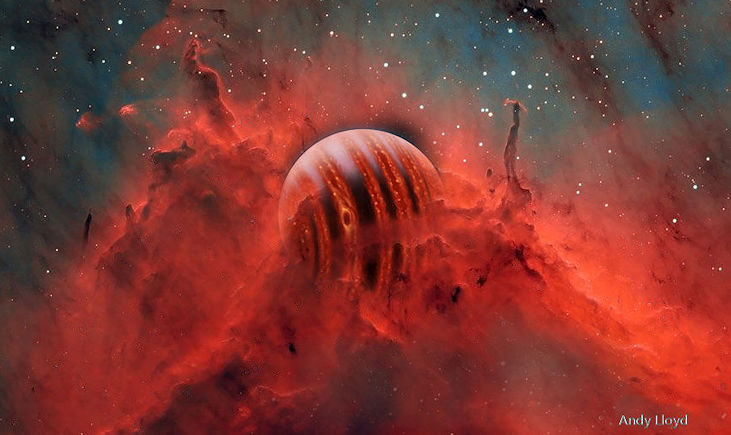
The Book of Revelation
The prediction for the next passage does not appear to be so fortuitous, perhaps indicating why the Anunnaki did not fulfil their promise to return in Jesus’ time. Kingship was not restored in the way that it had been promised. Instead, a new religion arose regarding the establishment of the Kingdom of God on Earth. With it came prophecies regarding ‘the next time’. Within the Book of Revelation there are references that have the distinct ring of the Dark Star about them.

Just as Nibiru brought catastrophe to Earth in the form of the Flood around 11,000 BC, so do certain prophecies portend future disaster following the Second Coming of the Lord. In Revelation 12:1-4;
“Next appeared a great portent in heaven, a woman robed with the sun, beneath her feet the moon, and on her head a crown of twelve stars. She was pregnant, and in the anguish of her labour she cried out to be delivered. Then a second portent appeared in heaven: a great red dragon with seven heads and ten horns; on his heads were seven diadems, and with his tail he swept down a third of the stars in the sky and flung them to the earth.” (1)
The pregnant woman in the sky is quite clearly Sirius, and this is a Christian rendition of the ancient Egyptian Isis myth. The moon is at her feet, implying that the scene is being observed upside-down, with the ecliptic below Sirius. This might imply the retrograde ‘birth’ of the Son celestially. The 12 stars in the crown are the lesser stars of the constellation Canis Major. Instead of the birth of the Celestial Messiah, however, this vision brings forth Nibiru and its moons in a far more malevolent aspect. Instead of Horus, we have Seth.
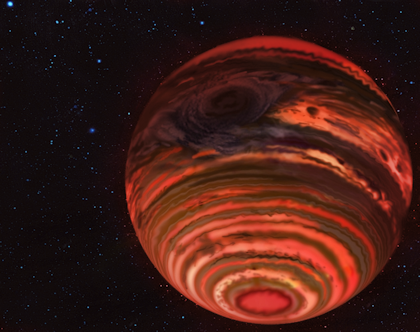
Ancient Sumerian religious texts described Nibiru as ‘the Lord’, and I think this was a device used by the early Christians, who appear to have understood this material well, but whose fledgling religion became irreconcilably altered through the reformation of Christianity by the Literalist Roman Church in subsequent centuries. Given that, it might be useful to try and make sense of these verses.
In His final teachings before His ascension, presumably back to Heaven, Jesus is said to have promised to return to Earth, prior to the Apocalypse, and save those faithful to Him by ascending them to Heaven. This was meant to have happened during the lifetime of the early followers, a claim that was either misunderstood, or simply not met. As such, the prophecy of Armageddon has remained with us down the centuries. It is linked with the appearance of a celestial ‘Satan’, that appears to resemble a ‘great red dragon’. We have already come across the ‘dragon’ imagery used to describe the dark star, and here we have it complete with 7 heads and 7 crowns, which would indicate to me the 7 moons.
“The seven heads are seven hills on which the woman sits. They represent also seven kings, of whom five have already fallen, one is now reigning, and the other is yet to come; and when he does he is only to last for a little while” Revelation 17: 9-10
The seven hills are allegorical for 7 celestial mountains, or planets, in the sense that Alan Alford has studied in great depth (2). The woman sat on the ‘hills’would indicate to me the presence of life on these moons, in a similar way that Gaia is the goddess of the Earth. The 10 horns are less easy to explain astronomically, and the Book of Revelation indicates that they are Kings who have yet to reign. This mirrors the verse above about the 7 Kings, of whom 5 have already reigned. This might correlate with the individual reigns of god-Kings for each Sar, or orbit of Nibiru. I wonder if these interpretations make reference to the number of Nibiruan passages left, in the same way that the demi-god reigns in the Egyptian and Sumerian King Lists allude to the passages of the Celestial Lord? In which case, which passage is the one that spells disaster?
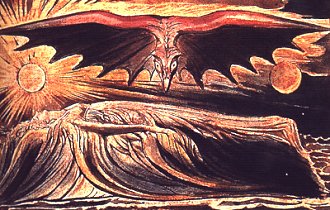
The verse containing the reference to a tail encompassing a third part of heaven certainly brings a comet to mind. The tail described is vast. The line also describes a casting of the stars down to Earth. This is either meteoritic bombardment, or the movement of the heavens as seen from Earth. Perhaps there will be another tilt of the axis of the Earth, with a repeat of the ‘sky falling’. Does the overall sense of this describe an astronomical phenomenon associated with the dark star Nibiru? I think that it does, and the link between this vision of Armageddon and the return of the Messiah further strengthens the case in my mind. In the Christian religion, the duality is between Christ and Satan.
While Satan destroys the world physically, the faithful are spiritually elevated by Christ.
The Book of Revelation contains much detail about the ‘Beast’ and the ‘Dragon’, that I presume to be a description of the red Star, the ‘planet’ Nibiru. There are many references also to the seven angels, who are the 7 moons of Nibiru. The Beast is both number 8, and also one of the seven:
“As for the beast that once was alive and is alive no longer, he is an eighth – and yet he is one of the seven, and he is going to perdition” Revelation 17: 11
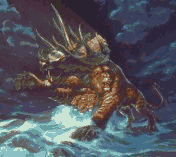
The Beast is the brown dwarf, a ‘planet’ that once shone brightly with its own light when primordial. It now gives out little visible light, and is a dark star. It is technically the 8th star in the configuration, yet its presence is really the essence of the 7 planetary ‘stars’ (moons), as it defines the Nibiruan system.
The number usually associated with the Beast is 666. In his book ‘The Cosmic Code’, Zecharia Sitchin has explored the meaning of this numerical figure using the methods of Gematria.
He has speculated that the meaning of this figure has less to do with the Greek word LATEINOS, depicting the Roman Empire, but instead was derived from the Hebrew SiTRO, which means ‘his secret’ or ‘his hidden thing’(3).
Sitchin then shows a link with the Sumerian-derived account of the Celestial Battle in the form of Psalms 18:
“The Earth shook
and trembled,
the foundations
of the hills were shaken…
There went up
smoke from his nostrils,
A devouring fire
went out of his mouth…
He made darkness
his
secret,
By a watery darkness and celestial clouds
covered.” Psalms
18: 8-12 [His emphasis]
Sitchin has not finished there. Taking the Biblical names for the planets of the Celestial Battle, Tehom Rabah, Sitchin concludes:
‘…then a numerical approach to the enigma of the “666” would suggest that the Book of Revelation was speaking of the Return of the Celestial Lord in a re-enactment of the Celestial Battle; for the sum total of the numerical value of Az [“then”] + Tehom + Rabah is 666.” (3)
He may be correct, as we are about to see. Zecharia Sitchin generally steers clear of Christian mythology, but this reference within the Book of Revelation to hidden knowledge about Nibiru strongly implies that the Christian religion itself is built upon such hidden teachings. The direct references to be found within the Book of Revelation begin to make a lot of sense when one bears in mind the image of the red coloured Celestial Lord with its seven attendant moons.
The Origin of 'Satan'
This dual identity in Judaeo-Christian myth between the Messianic Star and a celestial Anti-Christ, Satan, reflects the very same duality used by the ancient Egyptians. We have already seen how the dark star can take on the guise of the Messianic Horus, or the evil red-haired Seth. An isolated Kurdish sect maintains a belief in ‘Shaitan’, as well as a strong tradition connected with the Flood. The Yezidis live in the highlands of Eastern Turkey and believe that Shaitan is the ‘true force of divine power in the world, and that they themselves are descendants of Seth, the third son of Adam’ (4). In the same way as we reduce the ancient ‘Shumer’ to ‘Sumer’, Shaitan can be reduced to ‘Saitan’.
That this ancient and rather bizarre tradition is maintained at all is remarkable, given the persecution that the Yezidis have brought upon themselves for their ‘Satan-worship’. But the link with the Flood and the landing of the Ark of Noah in the very same mountains, might give us an insight into how a celestial ‘Satan’ was linked with the Flood in the first place.
The Nature of the Apocalypse
The nature of the Apocalypse, caused by a Nibiruan passage through the planetary zone, might take a number of guises. A straightforward analysis of the planetary interactions would have it that the close passage of Nibiru would directly cause a tilt of the Earth, or even a disruption to the orbit of our planet, by gravitational interaction. But this seems very unlikely at the distance we are talking of here, even at celestial Opposition. It is true that Nibiru passes within the orbit of Jupiter, and is a bigger body. But one recognises that even an alignment of the known planets causes no such gravitational effect, so why should Nibiru’s passage through the asteroid belt? Its gravitational effect will not be significantly greater than Jupiter. This has allowed many to dismiss Sitchin’s arguments about Nibiru’s powerful gravitational effect on the Earth, particularly as Sitchin regards Nibiru to be a much smaller body than I do. There are a couple of points to make that may make a direct gravitational effect more likely as a force to be reckoned with.
Firstly, the planets in the solar system are arranged in an orderly fashion, lying as they do on the same plane, the ecliptic. Pluto is an exception, but its nature is less planet-like than the others, anyway. The planets are also regularly spaced and enjoy roughly circular orbits. The forces between the planets and the Sun lie in two dimensions, across the plane of the ecliptic. Nibiru does not have this kind of orbit at all. It has a highly elongated orbit that is inclined to the ecliptic to a greater degree than Pluto. Its gravitational muscle will interact with the Earth in three dimensions, not two, and will potentially exert forces along the vector perpendicular to that of the other planets.
This would lend some credence to the idea that Nibiru could affect the Earth by its direct gravitational effect. However, the evidence within the solar system tends to negate this argument. Mars, for instance, would surely have a much more erratic orbit. The paper by Hills also gives theoretical findings that show us how little a brown dwarf would affect the orbits of the planets when one passes through the planetary zone:
“It is evident from the lack of damage to the planetary orbits that no Oort cloud object as massive as 0.05M* has passed through the planetary system since the dissipation of the solar nebula. Because the change in the eccentricity is proportional to the intruder mass Mi, any intrusions of objects from the Oort cloud having masses less than about 0.02M* = 20 Jupiter masses would not have produced a noticeable effect on the orbits of the planets. One or two such intruders could pass through the planetary system and not noticeably perturb the present orbits of the planets (unless an intruder happened to make an improbably close encounter with one of the planets, or unless its perihelion distance Rmin was very much less than the semimajor axes of the planets)”. (5)
M* is the mass of the Sun. Since the Perturber, our brown dwarf Nibiru, has been calculated to have only several times the mass of the planet Jupiter, it falls well within this limit set by Hills. As such, it will not alter the orbits of the planets unless it makes an ‘improbably close encounter’, which is highly unlikely given that perihelion is around the position of the asteroid belt. So Nibiru will not adversely affect the Earth directly.
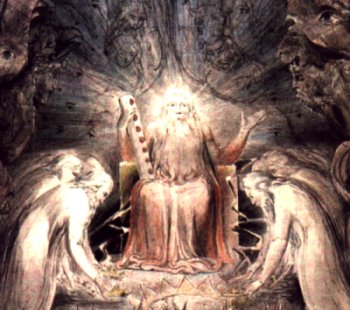
But the ‘binding energies’ of the planets gives as a different perspective on how planets can affect each other’s orbits, and in that I think we can find a clue to how the ‘sky fell’. In turn, this could indicate how the Earth could once again be affected by the perihelion passage of the dark star. If Nibiru’s orbit is unstable, and it would certainly appear to be, then changes affecting it would then have a knock-on effect on the other planets.
If the Anunnaki were
able to discern the solar system planetary configuration when Nibiru next
passes through, and this does not appear to be an unreasonable supposition,
then they might be able to predict when problems might occur. Remarkably,
this would very much depend on the alignments of the planets, as seen from
Earth.
Let me explain. If Nibiru passes through a zodiacal house during its perihelion passage (either Leo/Cancer or Taurus/Aries), and at that time there are other planets in that constellation, then the alignment would indicate conjunction with those planets. This doesn’t necessarily hold for Mercury or Venus, but these two inner planets are unlikely to make a difference to Nibiru anyway. The real players are Jupiter, Saturn and possibly Uranus and Neptune, or even Mars.
When Nibiru lines up with one of these planets as it transits the planet’s ‘station’, then its unstable orbit might be affected by the close passage past the planet. It could experience a small sling-shot action, and this might alter its orbit once again. The stable, known planet would be less likely to be affected because it sits in a stable orbital configuration and is ‘shepherded’ by the Sun’. Nibiru is far more erratic, and a small tug could potentially make a bigger difference to its orbit, as the calculations by Hills show (5). A change in Nibiru’s orbit would change its biding energy and, thus, the binding energies of the other planets. Hence, the ‘sky would fall’. Without coming near the Earth, Nibiru could cause massive damage to the Earth’s orbit, tilt and environment.
From the perspective of observers on Earth, the zodiacal alignments of the planets during the Nibiruan perihelion passage take on great importance. Astrology then takes on an entirely new meaning. The configurations of the planets during the perihelion passage would indicate in advance the fate Earth would suffer. Planets at opposition to each other would mean a peaceful transit of the dark star, but planets in conjunction could potentially spell disaster. I suspect this is where the ‘12 planets’ really takes on meaning. Nibiru offers the key to our understanding of ancient astrology, and potentially leads us to daring conclusions about the work of astrologers and seers like Nostradamus.
If the Book of Revelation sets out the nature of the next orbit, then we might find the following passages of great interest:
“But one of the elders said to me: ‘Do not weep; for the Lion from the tribe of Judah, the Scion of David, has won the right to open the scroll and break its seven seals’”. Revelation 5: 5
This reference to the Lion is made in conjunction with the ‘Scion of David’ (the ‘Star’) and the breaking of the seven seals (the appearance of the 7 stars of Nibiru):
“I, Jesus, have sent my angel to you with this testimony for the churches. I am the scion and offspring of David, the bright star of dawn.” Revelation 22:16
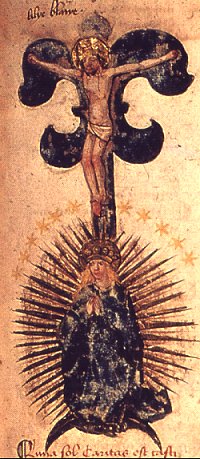
So Jesus is equated with the Scion of David, and is the bright star of dawn. He is the human embodiment of the Messianic Star. We already know that Nibiru cuts across the ecliptic in Cancer, moving from Leo as it does so, and the relative perspective of the constellation Nibiru appears in at that point depends on the Earth’s position relative to the Sun and Nibiru at the time. For the ‘seven seals to be broken’ when Nibiru transits Leo is highly likely, as the stars begin to appear as Nibiru rushes towards perihelion. This passage sets the scene for what is to come.
The Apocalypse is tied to the Lamb, who is equated with Christ. But the Lamb could also be an astronomical reference, tying Nibiru to the zodiacal constellation of Aries. Nibiru passes through Aries as it leaves the perihelion voyage to exit the solar system, and this occurs as Nibiru again cuts the ecliptic. In the same way that Orion is associated with the Flood passage of Nibiru, Aries appears to be associated with the passage of the future Apocalypse. The fight between the Lamb and the dragon, or beast, appears to refer to Nibiru’s transit through Aries, and the disaster that ensues. Does Jupiter lie in Aries at the time?
“Then I looked, and on Mount Zion stood the Lamb, and with him were a hundred and forty-four thousand who had his name and the name of his Father written on their foreheads.” Revelation 14:1
Does Mount Zion refer to one of the planets, possibly Jupiter or Saturn, lying in Aries as Nibiru ascends towards this constellation from the Duat? The figure 144,000 is not a reference to the number of human followers of Christ, but to years.
144,000 is divisible by one Nibiruan orbit of 3,600 years by exactly 40, and so this verse clearly alludes to 40 orbits of Nibiru. The Celestial Battle of the Apocalypse as described in the Book of Revelation is a complex affair. It appears to describe the same events over again, giving the impression of a succession of actions, when they might be accounts of a few celestial movements in the sky. The dragon is thrown down from the sky, for instance, and this might allude to its drop into the Duat, or to the sky falling during the ensuing battle. There is a great struggle between good and evil, before the beast is finally chained up. But its banishment into the abyss is only 1000 years, and this might indicate a major change in Nibiru’s orbit as a result of this new Celestial Battle:
“Then I saw an angel coming down from heaven with the key of the abyss and a great chain in his hands. He seized the dragon, that serpent of old, the Devil or Satan, and chained him up for a thousand years; he threw him into the abyss, shutting and sealing it over him, so that he might seduce the nations no more until a thousand years were over. After that he must be let loose for a while.” Revelation 20: 1-4
After this period of one thousand years, during which Christ’s peace reigns on the Earth, and the Christian martyrs have been resurrected, the celestial ‘dragon’ returns from his dungeon in the abyss. Then follows the Day of Judgement. The followers of Christ find a new home in Heaven, where the light of the Moon and Sun are no longer required. This celestial vision ends the Prophecy, perhaps alluding to everlasting life in the Nibiru system.
The Book of Revelation can be interpreted in many ways. It is full of colourful imagery, and is difficult to fathom, but there are celestial references contained within that appear to marry well with the older mythologies that pre-dated Christianity. The allegories contained within this book of prophecy may stem from those older myths about the Winged Disc. More frightening still is the possibility that the astrology of Nibiru’s perihelion may have indicated to the ancients that the next passage spelt trouble.
Written by Andy Lloyd, April 2001
author of 'The Dark Star' (2005), 'Ezekiel One' (2009), 'The Followers of Horus' (2010) and 'Darker Stars' (2019)
Published by Timeless Voyager Press
References
1) Thanks to P. Mistlberger, Rowland BBS ‘Zecharia Sitchin’ April/May 2000
2) Alan Alford “When the Gods Came Down” Hodder & Stoughton 2000
3) Zecharia Sitchin "The Cosmic Code" pp166-8 Avon 1998
4) David Rohl “Legend: The Genesis of Civilisation” p146 Arrow 1998
![]() Legend: The Genesis of Civilisation
Legend: The Genesis of Civilisation
5) Jack Hills "The Passage of a "Nemesis"-like object through the Planetary System" The Astronomical Journal, 90(9): 1876-1882, September 1985
Images:
1.Detail from: 'Jerusalem' (c. 1804-1820, William Blake)
2. The Beast. Borrowed from somewhere on the Net. Neat pic, even if it probably isn't what the writer of Revelation had in mind...
3. "The Four and Twenty Elders Casting their Crowns before the Divine Throne" (c.1803-5, William Blake, at the Tate Gallery, London)
4.
Buch der Heiligen Dreifaltigkeit, early 15th Century ("The seven planets,
metals and virtues and assigned to his extremities, his body and his wound
in his side" Alexander Roob, Taschen 2001)
One Thousand Years to The Day...
Here are some additional points made by Larry Schamber, who considers it possible that there is a coded reference to the orbital period of Nibiru in the Book of Revelation. A Day signifies a Millennium, and the many references to 3.5 days hence allude to a Nibiruan Age:
"I'll give the 1000 years is a day first:
Psalm 90:2-4
Before the mountains were brought forth, or ever thou hadst formed the earth and the world, even from everlasting to everlasting, thou art God. [3] Thou turnest man to destruction; and sayest, Return, ye children of men. [4] For a thousand years in thy sight are but as yesterday when it is past, and as a watch in the night.I include the following because through connections that I cannot quite explain, I believe this could be a prophesy of the return of Christ. The "in the fourth watch in the night" could be interpreted as a passage of 3.5 times = 3.5 God's years = 3500 years.
If that is the key then the rest of the interpretation easily falls out...The sea = abyss = the visible arch of sky = the changeable future (sea is like the future, fluid, in flux and always subject to change) ... Mindful of this analogy we could see the meaning of Jesus walking upon the waters:: Jesus walking in the heavens. A wandering object in the heavens could be Nibiru.
Rev. 11:9 And they of the people and kindreds and tongues and nations shall see their dead bodies three days and an half, and shall not suffer their dead bodies to be put in graves.
Rev. 11:11-13 And after three days and an half the Spirit of life from God entered into them, and they stood upon their feet; and great fear fell upon them which saw them. [12] And they heard a great voice from heaven saying unto them, Come up hither. And they ascended up to heaven in a cloud; and their enemies beheld them. [13] And the same hour was there a great earthquake, and the tenth part of the city fell, and in the earthquake were slain of men seven thousand: and the remnant were affrighted, and gave glory to the God of heaven.
Something to think about."
Larry
5th November 2001
The Hampton Throne
Greg Jenner has been researching the enigmatic 'Hampton Thrones' and wonders whether the mix of Winged Disc symbolism and anticipation of the second Coming of Christ could be interlinked:
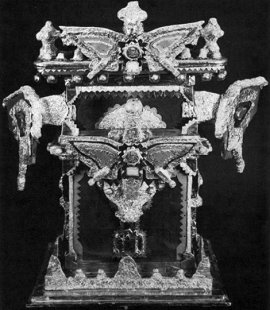
"Andy,
Thought you might be interested in this:
I got my hands on an interesting book called ‘Time’s Arrow Time’s Cycle – Myth and Metaphor in the Discovery of Geological Time’ by: Stephen Jay Gould. Copy-rite 1987, Harvard University Press.
On page 181 Gould mentions a person named James Hampton who was an African American originally from South Carolina and later became a janitor in Washington D.C. (1909-1964). Beginning in 1931 he had ‘instructions’ from angels to build a throne for the second coming of Christ and as it turns out he built 177 pieces altogether for his ‘Christ throne room.’ He eventually died in 1964 but left behind some very unusual artwork pieces that you can now view at the National Museum of American Art in Washington D.C.
What caught my attention though was the re-occurring theme of a ball with wings splattered throughout his artwork. Where have we seen this symbology before?! What is so amazing to me is the entire book is devoted to THE CYCLE OF TIME, and the BALL WITH WINGS on Hampton’s throne is a great example of this.
Was Hampton visualizing Nibiru? I think so!"
From Greg Jenner, 16th March 2004